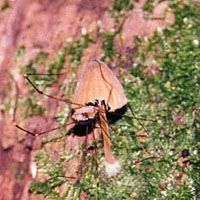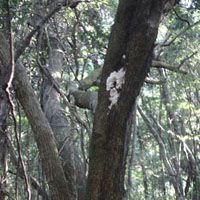'Look over there! Turn out your flashlights," exclaimed Kunihiko Otsuki one recent Sunday night as he stood in an area of broadleaf mixed woodland with five other forest enthusiasts.
With the lights off, the forest returned to its primordial blackness. Below, the ocean lapped gently against the shores of the small, forest-covered island of Mesameyama in Ugui, Wakayama Prefecture, where the group stood. Only a few shafts of moonlit sky broke through But eyes adjust to darkness, and gradually a cluster of glowing green dots became visible on the forest floor: luminescent mushrooms.
Each rainy season in Japan — which, roughly speaking, comes in June — these otherworldly fungi sprout from rotting wood on the forest floor and attract hundreds of visitors from around the country. Like fireflies, luminescent squid, and other so-called bioluminescent organisms, glow-in-the-dark mushrooms contain an enzyme known as luciferese. When luciferese is oxidized (i.e. comes in contact with oxygen), it emits energy in the form of light, which causes organisms containing it to glow.
Around 10 varieties of luminescent mushroom are believed to grow in Japan, and many more exist in other parts of the world. The variety of luminescent fungus that Otsuki studies is called Mycena lux-coeli, or "heavenly light mushrooms," a variety that glows a bright greenish-white. In daylight, the 1- to 2-cm-wide mushrooms resemble Japan's well-known brown enoki mushrooms, and for a long time they were thought to exist only on tiny Hachijo-jima Island 300 km south of Tokyo, where they were known to locals as hato-no-hi, which translates as "pigeon fire" — as they were scientifically named in 1954.
In 1995, though, researchers discovered the same mushrooms growing in deeply rural Susami-cho in Wakayama Prefecture. Since then, Otsuki and his colleagues have trekked through the woods there on countless nights in search of Mycena lux-coeli. They have discovered that the mushrooms are a common species in the natural broadleaf forests throughout the Kii Peninsula, and are also found on Kyushu.
For Otsuki, who used to work as a researcher at the Wakayama Forestry Research Center but now thins trees for a timber company, the fact that these mushrooms were officially discovered in the area just 13 years ago says a lot about the nature of forests.
"Even now, new organisms are being discovered. We don't yet know what's out there in the forest. It's still an unknown world," he says.
And from that unknown world, Otsuki continues to unearth new types of mushrooms.
Back on Mesameyama, he crouched down under a tree and peered at the thick layer of damp leaves covering the forest floor. But then, as he turned out his light, a constellation of luminescent specks slowly appeared, until the forest floor seemed to be reflecting a starry night sky.
"These are luminescent leaves," said Otsuki, scooping up a handful for closer examination.
Actually, it's not the leaves themselves that glow, but another even tinier variety of yet-unnamed luminescent mushrooms. Threadlike mycelium, similar to the stems and roots of all other mushrooms, also criss-cross the leaves with their glowing filaments.
No one knows exactly why the mushrooms glow, but Otsuki presented one theory at a joint meeting of the Mycological Societies of Japan and America in Hawaii in 2005.
"I can't say for sure, but I think the mushrooms may glow in order to attract insects," he said. He has documented crickets and daddy-longlegs crane flies in the act of munching on glowing mushrooms. These insects then distribute the spores throughout the forest via their droppings. Think about the way bugs flock to a lantern at night, and the theory starts to seem pretty plausible.
Otsuki says he's found these fantastic fungi only in native forests with many large trees, and where humans have interfered little — in particular on the wooded land surrounding shrines. Mycena lux-coeli is found almost solely on large shi-no-ki trees (Castanopsis sieboldii, or chinkapins in English), one of the dominant climax species in the native forests of the Kii Peninsula.
But while various types of mushrooms are abundant in native broadleaf forests in Japan, they are scarce in the man-made hinoki (Japanese cypress) and sugi (Japanese cedar) plantations that now make up nearly half of Japan's forests.
In other words, this unusual species depends on native broadleaf forest for its survival. Otsuki says that taking visitors out to see the mushrooms is one way to raise their awareness about natural forests in general.
"I want to show people how interesting the forest is," he says.
Shigeru Nishigaito, a volunteer guide who leads walks on Mesameyama from May to the end of June, agrees that the luminescent mushrooms provide a unique opportunity to get out in the woods.
"For many people, [coming on our tour] is the first time they've come into the forest at night. Everyone is really delighted by these mushrooms," he says.
Native broadleaf woods made up approximately 44 percent of Japan's 25 million hectares of forested land in 2000, according to statistics from the Ministry of Agriculture, Forestry and Fisheries. Plantations accounted for about 41 percent of forested land nationwide, but more than 60 percent in Wakayama.
Man-made forests in Wakayama date back to the Edo Period (1603-1867), but they became much more widespread after World War II. Much of the broadleaf forest (whose trees were once prized for charcoal) was cut down for the war effort and replaced with varieties that could be sold for lumber. But in recent years, many of these man-made forests have been neglected and are widely blamed for a range of environmental problems, including widespread pollen allergies.
"The plantations aren't necessarily bad," says Kiyoshi Takenaka, a native of rural Nakaheji village in Wakayama Prefecture, who is president of Ichiigashi-no-kai, a volunteer group working to restore the region's forests. "But there are places that are suited to such forests and places that are not. We want to start little by little bringing back the native forest to those places that aren't suited to plantations."
Though the plantations provide direct economic benefits, Takenaka says the native forests provide a much broader — if less direct — range of benefits.
"Soil, water, air — these are all things that humans need," he says. He believes the abundance of inter-related organisms that make up native broadleaf forests is critical to maintaining a safe supply of all three.
"It's impossible for humans to re-create native forests," says Takenaka. "It will take hundreds — or thousands — of years for such complex forests to re-establish themselves. But if we don't start doing even a little bit now, this forested region as it once was is going to disappear."
The fate of Mycena lux-coeli and countless other as yet undiscovered species may just rest on whether or not he succeeds.
Tours of Mesameyama are going on through the end of June. For more information, contact the Ugui Visitors Center on (0735) 54-2510 (Japanese only), or fax (0735) 54-1540 (Japanese or English). winnie























With your current subscription plan you can comment on stories. However, before writing your first comment, please create a display name in the Profile section of your subscriber account page.